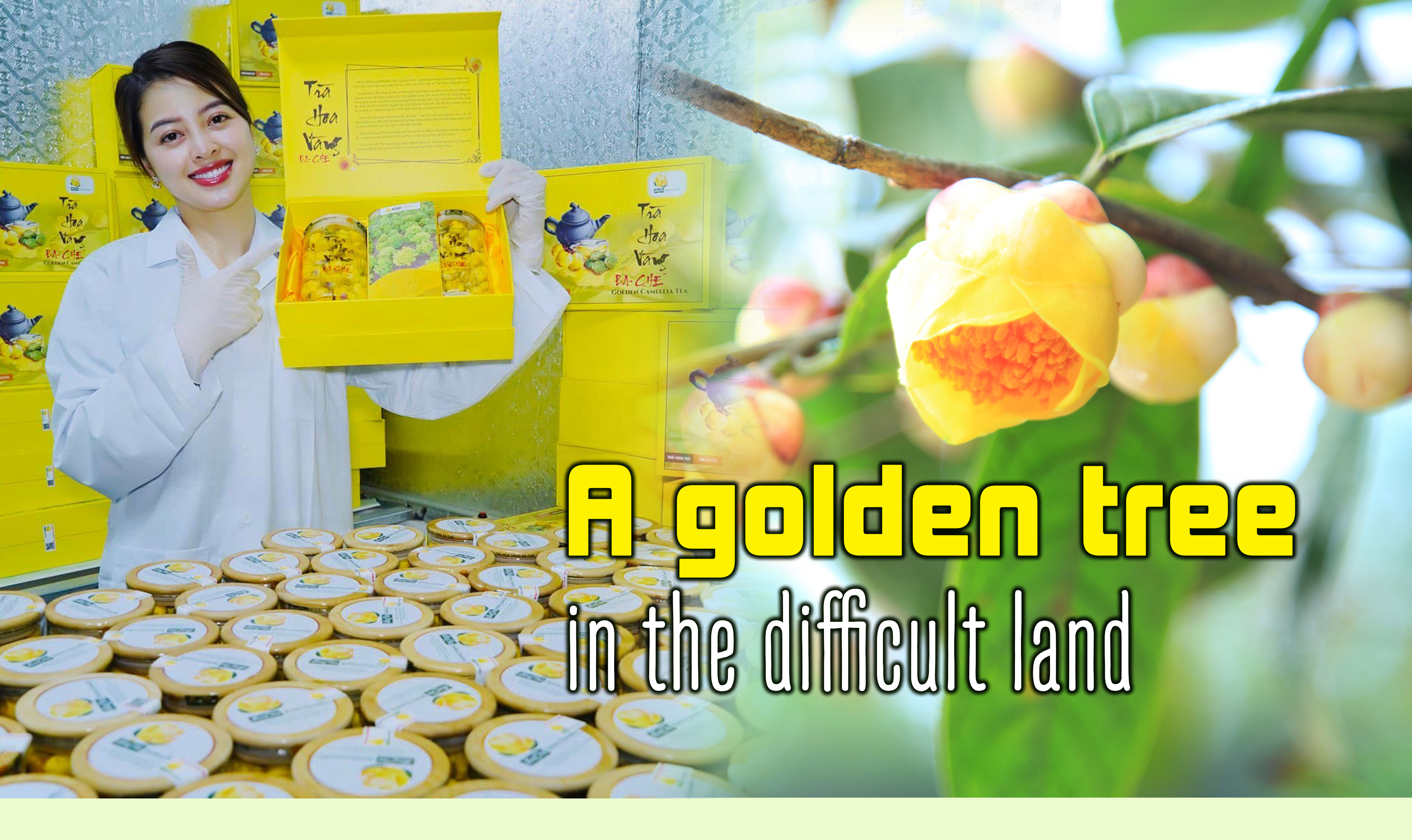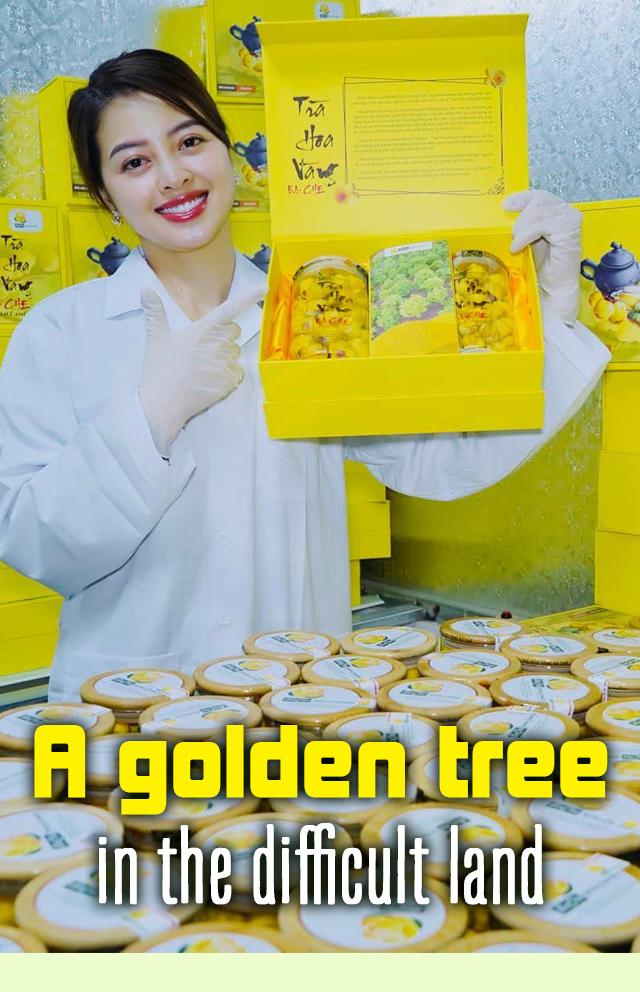Many years ago, golden camellia was bred by people in the mountainous district of Ba Che (Quang Ninh province) from the plant growing naturally in the forest. Realizing the value of golden camellia, in 2010, people in the district planted it in a concentrated area. Up to now, golden camellia is considered a tree variety as precious as gold to the Ba Che people, with the selling price of dried flowers ranging from VND 12–13 million/kg.

About 30 kilometers from Ba Che town (Quang Ninh province), Dap Thanh commune is considered the "capital" of golden camellia trees in the mountainous district of Ba Che.
Mr. Ninh Van Trang, Director of Dap Thanh Forest Products Trading Joint Stock Company (Dap Thanh commune, Ba Che district), shared that the golden camellia tree is an indigenous species, growing naturally in the forest beside ravines and creeks.
Previously, there was a time when traders were eagerly seeking to buy golden camellia trees. People going into the forest often dig up plants to sell to foreign traders at a price of about VND 1.5–2 million/tree. Therefore, natural golden camellia trees are becoming less common and are at risk of disappearing.
As a Dao ethnic person born and raised in the mountainous district of Ba Che, many years ago, Mr. Trang used to go into the forest to find and collect this type of flower to sell. Realizing the great benefits that the golden camellia tree brings, Mr. Trang chose to grow the tree instead of selling it. It is known that Mr. Ninh Van Trang is one of the pioneers in planting, restoring, and preserving the golden camellia tree.
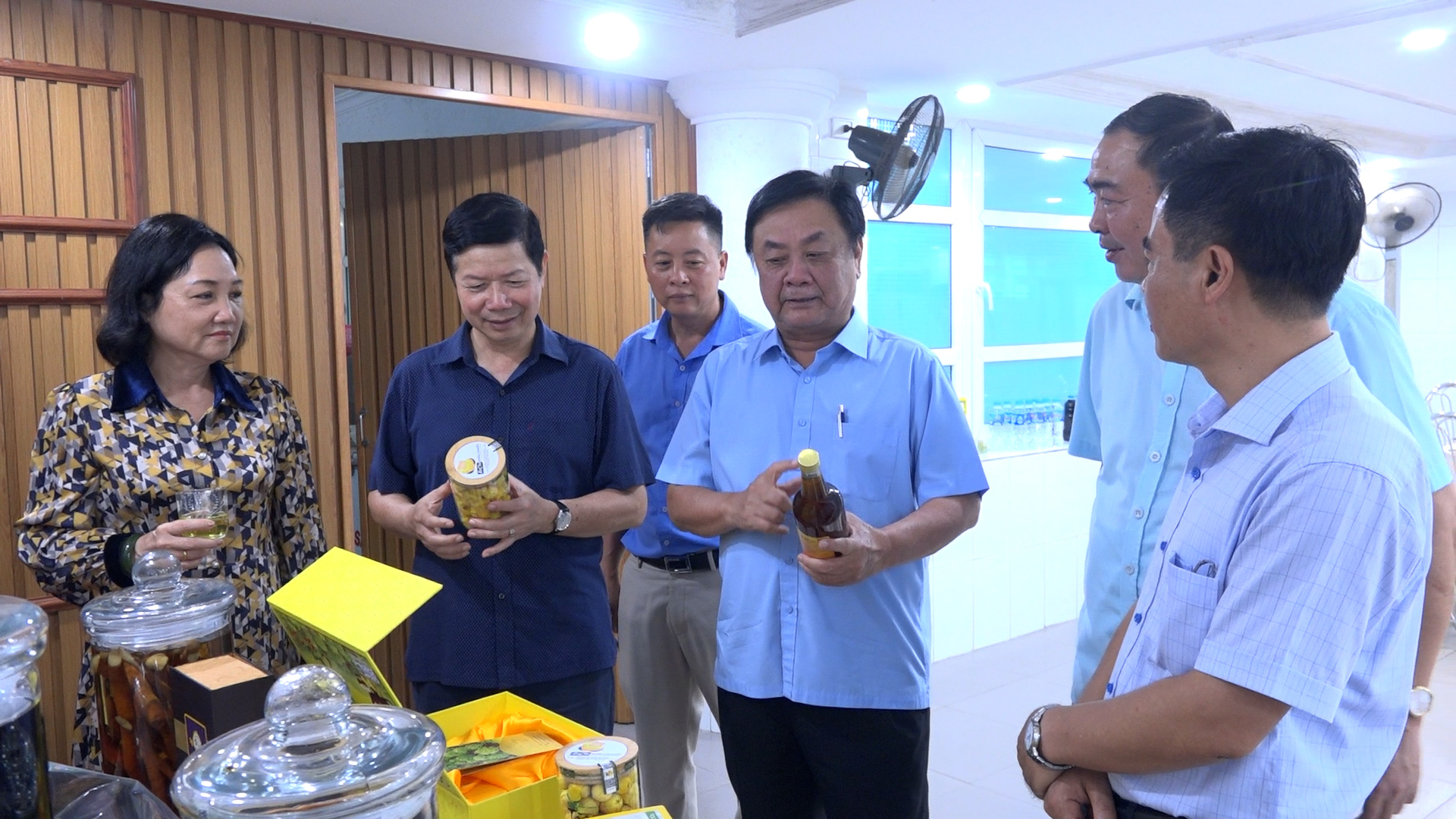
However, when discussing it with his family, many of his relatives expressed concern and disagreement. Recalling that time, Mr. Trang still cannot forget his father's harsh reaction. “My father opposed it fiercely at that time. He stopped eating for several days. He scolded, ‘If you can't do it, you have to leave the land for your children to work on. If we exchange fields, what will we eat?"
Fortunately, his wife, Mrs. Nguyen Thi Bay, supported and always encouraged him to realize his dream. In early 2009, Mr. Trang started implementing a project to plant precious tea trees on 3,000 m2 of the family’s land and all the capital accumulated by the couple over many years, along with bank loans.
Mr. Trang bought thousands of golden camellia trees from people to plant. At that time, the San Chi ethnic man took the forest as his home and the stump as a place to eat, drink, and rest. Every day, he and his relatives put all their effort into taking care of this tree species, hoping that it will grow quickly, be healthy, and produce many camellia flowers.
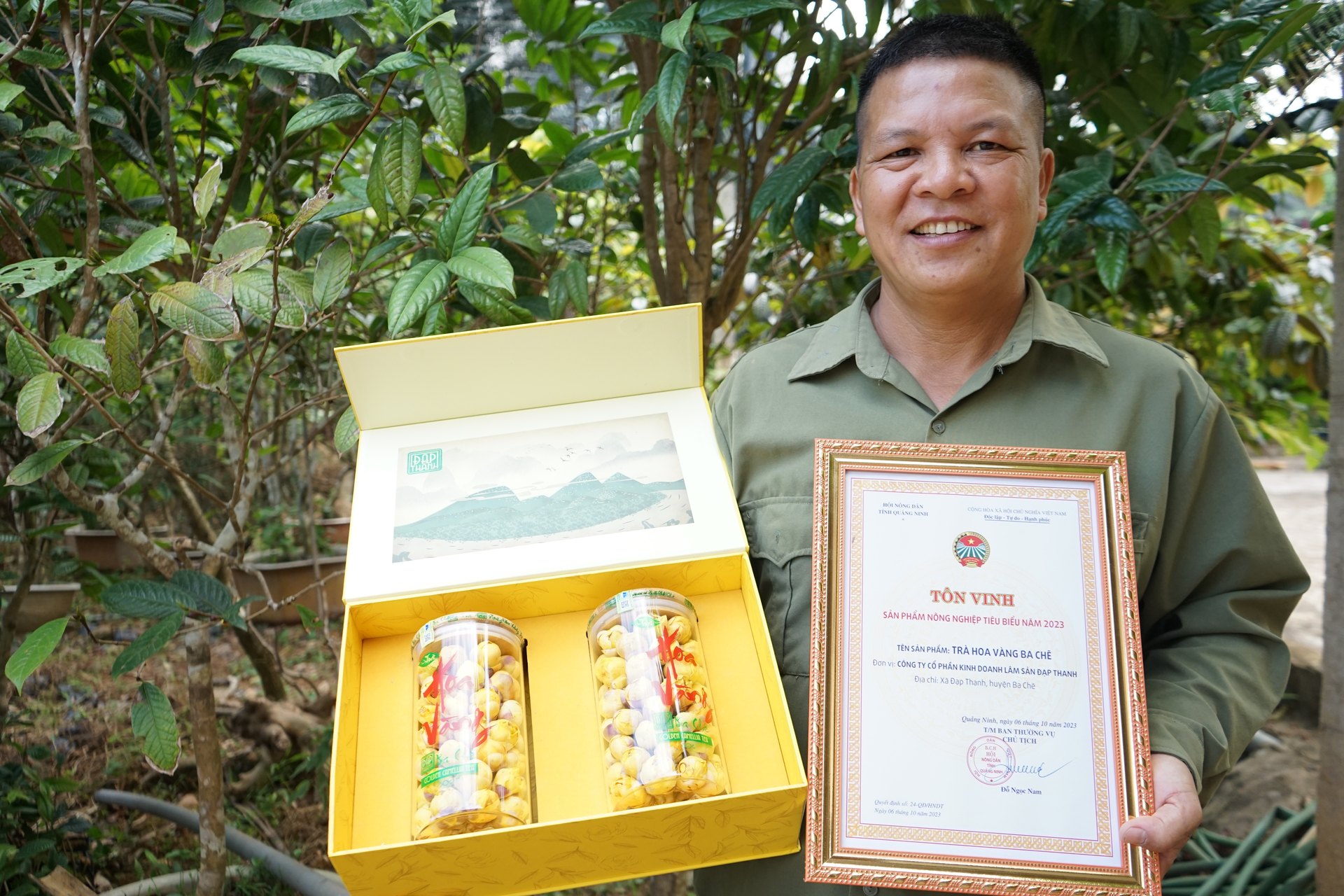

Excitement is that, but God does not please people. Due to a lack of experience and technology, and especially because this plant is inherently not suitable for hilly soil but only grows healthily when growing in the forest adjacent to deep ravines, the seedlings planted by Mr. Trang gradually weakened and died.
“There was a time when nearly 50% of the seedlings died and had to be dug up and thrown away, which was painful to look at. At that time, I was so discouraged and just wanted to give up. However, I was passionate about this plant. In addition, my wife encouraged me that if I quit in the middle, it would be a waste of the effort and money I had invested. Therefore, I still decided to conquer it," Mr. Trang recalled.
Gaining approval from his family was difficult, but mastering the technology of growing and caring for the golden camellia was even more challenging for him. The golden camellia tree originally liked the shade, and now, when planted on the hill, the tree must be watered and planting distance must be ensured. If planted too thickly, the plant will die.
Determined to the end, Mr. Trang researched day and night to save his newly planted forest. Because no one has successfully grown this type of tree yet, he could not learn from someone's experience. He started with the problem of creating humidity and coolness for the tree by using many pumps, pumping water abundantly and regularly every day.
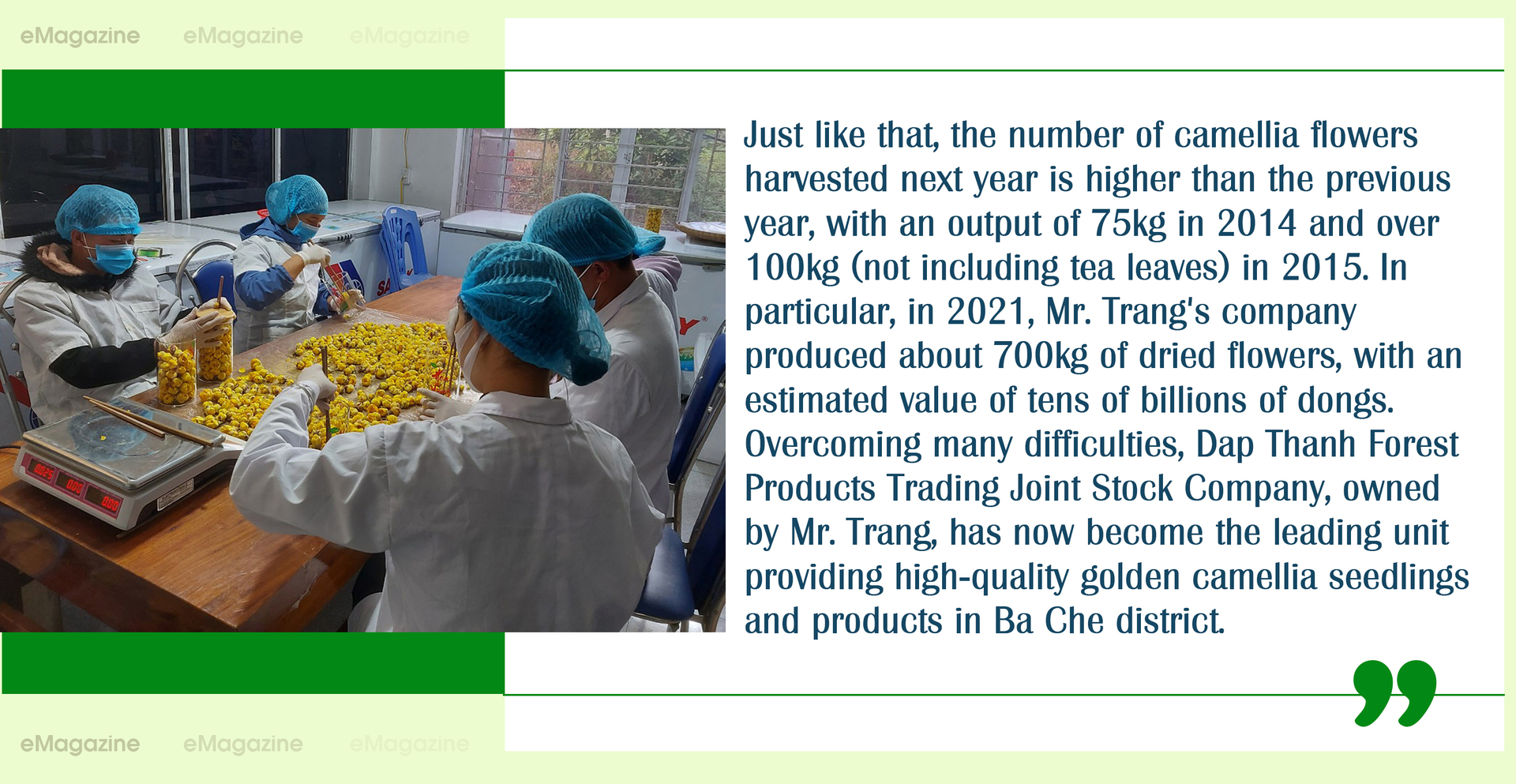
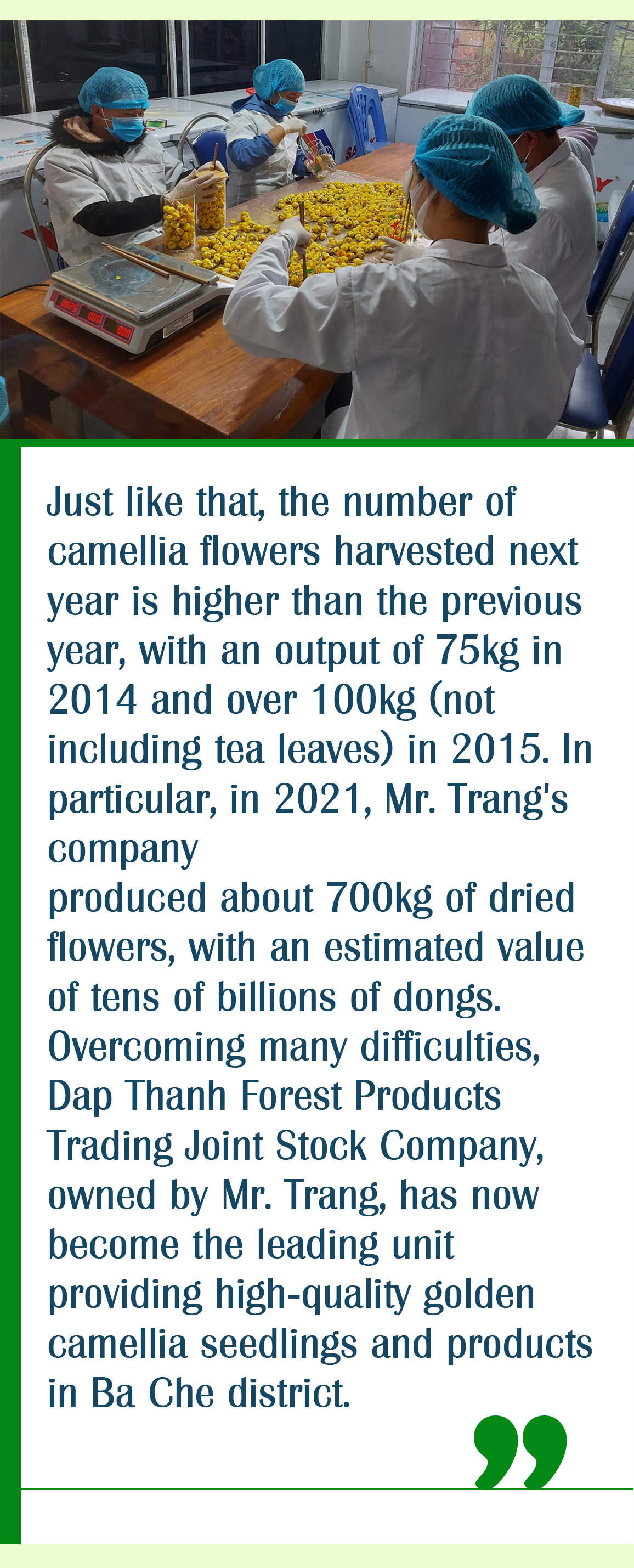
Indeed, these tea trees have become greener, and their leaves have grown faster. After many years of losing sleep, by 2013, thousands of golden camellia trees owned by Mr. Trang and his wife had buds. That day, his family was as happy as finding gold.
Mrs. Nguyen Thi Bay recounted that when the tea tree had buds and then bloomed bright yellow flowers, the couple could not hide their emotions. "From that moment on, I thought that we could eat well and sleep peacefully," Mrs. Bay tearfully said.
The initial step was successful, but more than 1,000 tea trees on an area of 3,000 m2 only yielded 15kg of flowers in the first year. Once again, the problem of productivity needed to be solved by Mr. Trang. He researched how to take care of this plant more effectively. Mr. Trang alone had to travel throughout the provinces and then go to China to learn techniques.
At the same time, he researched whether, in addition to the flowers, the leaves of this plant could be used or not. After this type of leaf was determined by experts to have good uses such as reducing blood lipids and regulating blood pressure, Mr. Trang picked it, chopped it, dried it, and packaged it into filter bags to sell with flowers.
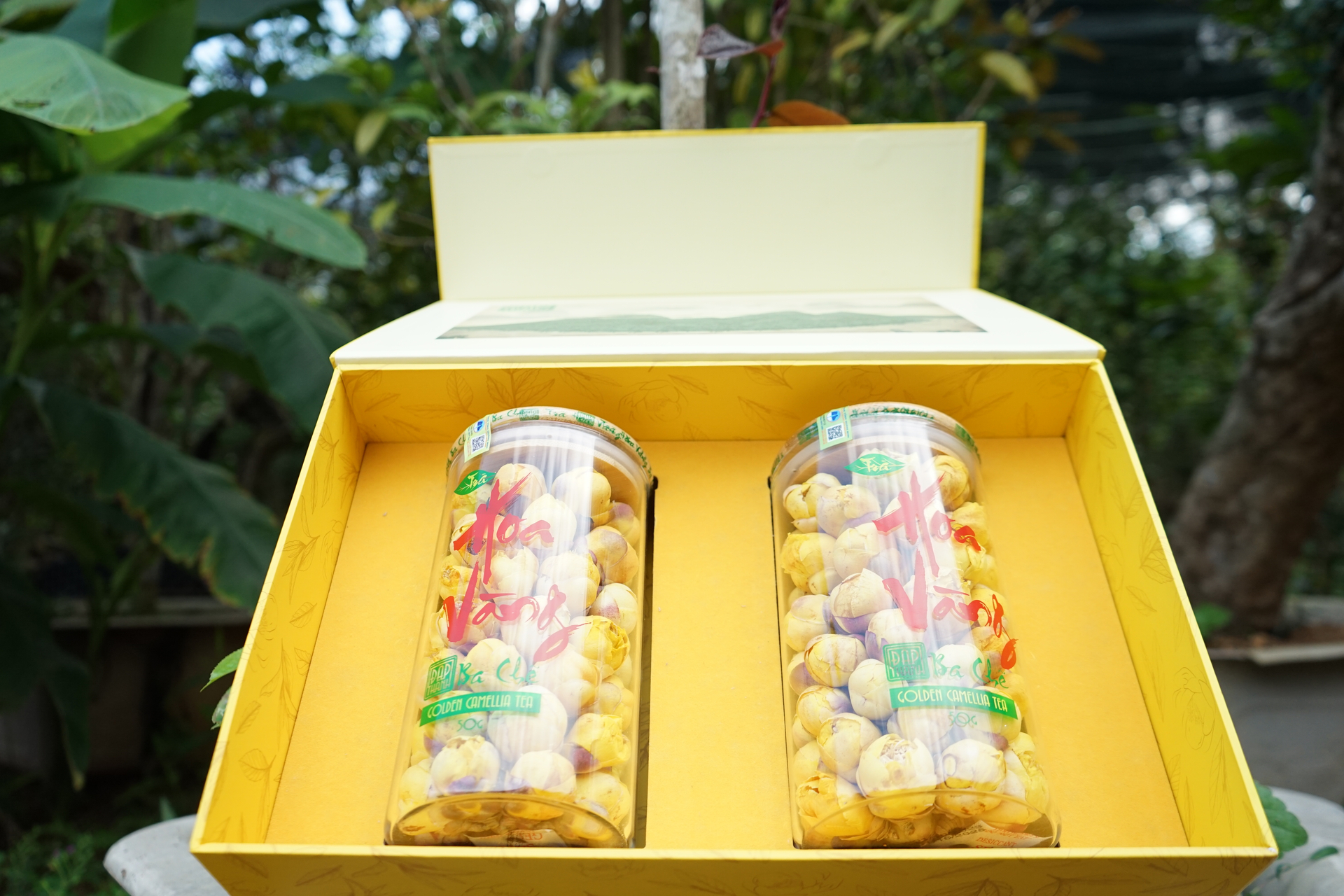

Not only mastering growing techniques, Mr. Trang also perfected the production process of freeze drying so that camellia flowers retain their color, flavor, and pharmaceutical value. He also standardized the tea production process, from selection to packaging.
According to Mr. Trang, the current price of dried camellia flowers sold to the market is VND 12–13 million/kg. A box of dipped tea leaves costs VND 60,000. In addition to income from camellia flowers and tea leaves, he also successfully nursed 100,000 tea seedlings and sold them at a price of VND 35,000/tree.
From a wild forest plant, golden camellia was restored, becoming a main crop in Ba Che. With high and stable selling prices, the flower species that is likened to gold has been bringing hundreds of millions of dong each year to growers, helping them not only escape poverty but also rise to get rich.
Ba Che golden camellia tea is now certified as a 4-star OCOP product. Not stopping there, this product is also aiming to become a national OCOP product.
Currently, this precious type of tree is growing well, from seedlings to deeply processed products. Golden camellia tea is both a high-value drink and a rare and precious medicinal herb, and it increasingly stands firmly in the market.
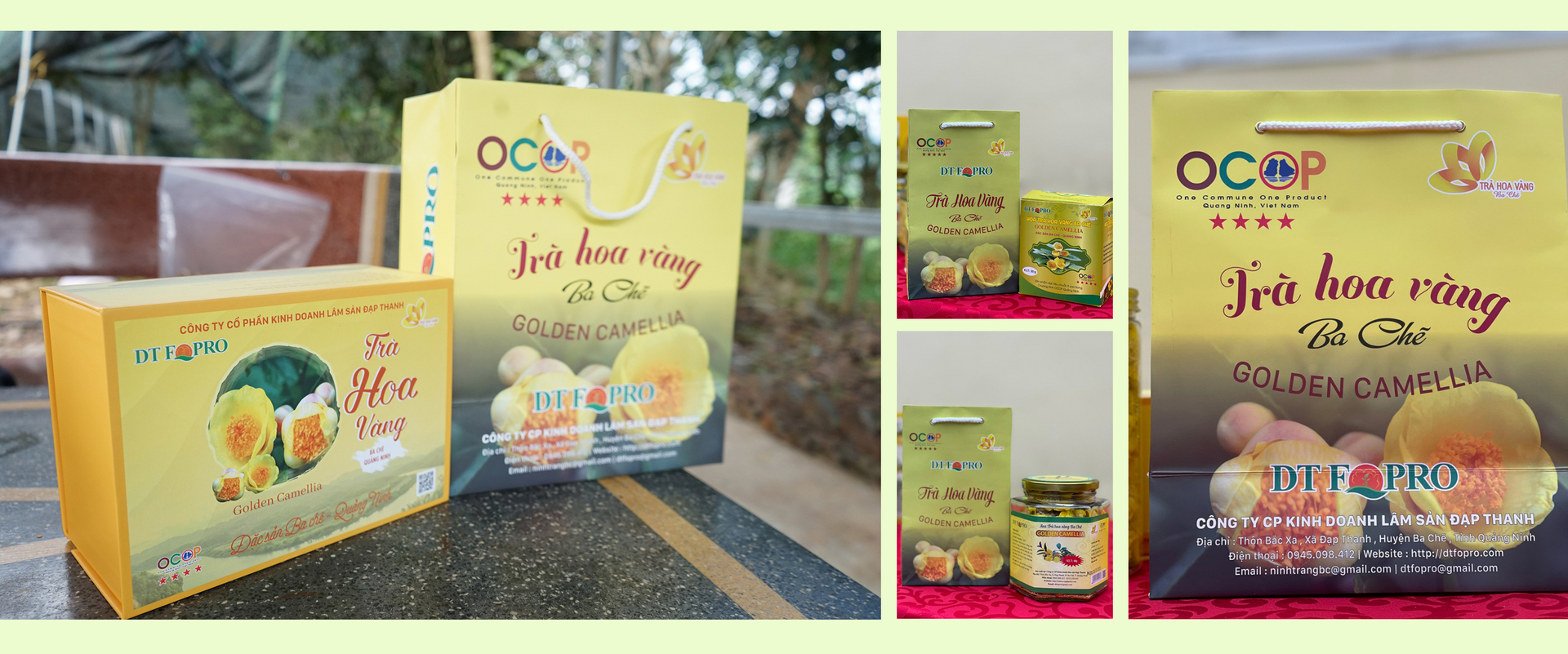
The processes of growing, caring for, processing, and propagating Ba Che Golden Camellia Tea products ensure strict standards. The pre-processing and processing processes meet the standards of the advanced quality management systems HACCP and ISO 9001:2015, with freeze drying technology to help preserve the pure flavor and many inherent valuable nutrients of golden camellia.
The "sublimation" of the golden camellia tree on the land of Ba Che is not only the story of pioneering farmers who dare to think and do like Mr. Trang but is also evidence of the correctness of the guideline of turning Ba Che into the center of forestry economics and medicinal plants in Quang Ninh province.
Currently, the golden camellia-growing area in Ba Che district has developed to nearly 300 hectares. The profession of growing this precious medicinal plant not only creates livelihoods and helps people get rich, but also creates unique cultural values and is the foundation for the mountainous district of Ba Che to develop tourism services.
In order to contribute to improving the economic value of the golden camellia tree, Dap Thanh Forest Products Trading Joint Stock Company has supported purchasing flowers from ethnic minorities in Ba Che district. Thereby, the company processed them into products, creating jobs and a stable income for many local workers.
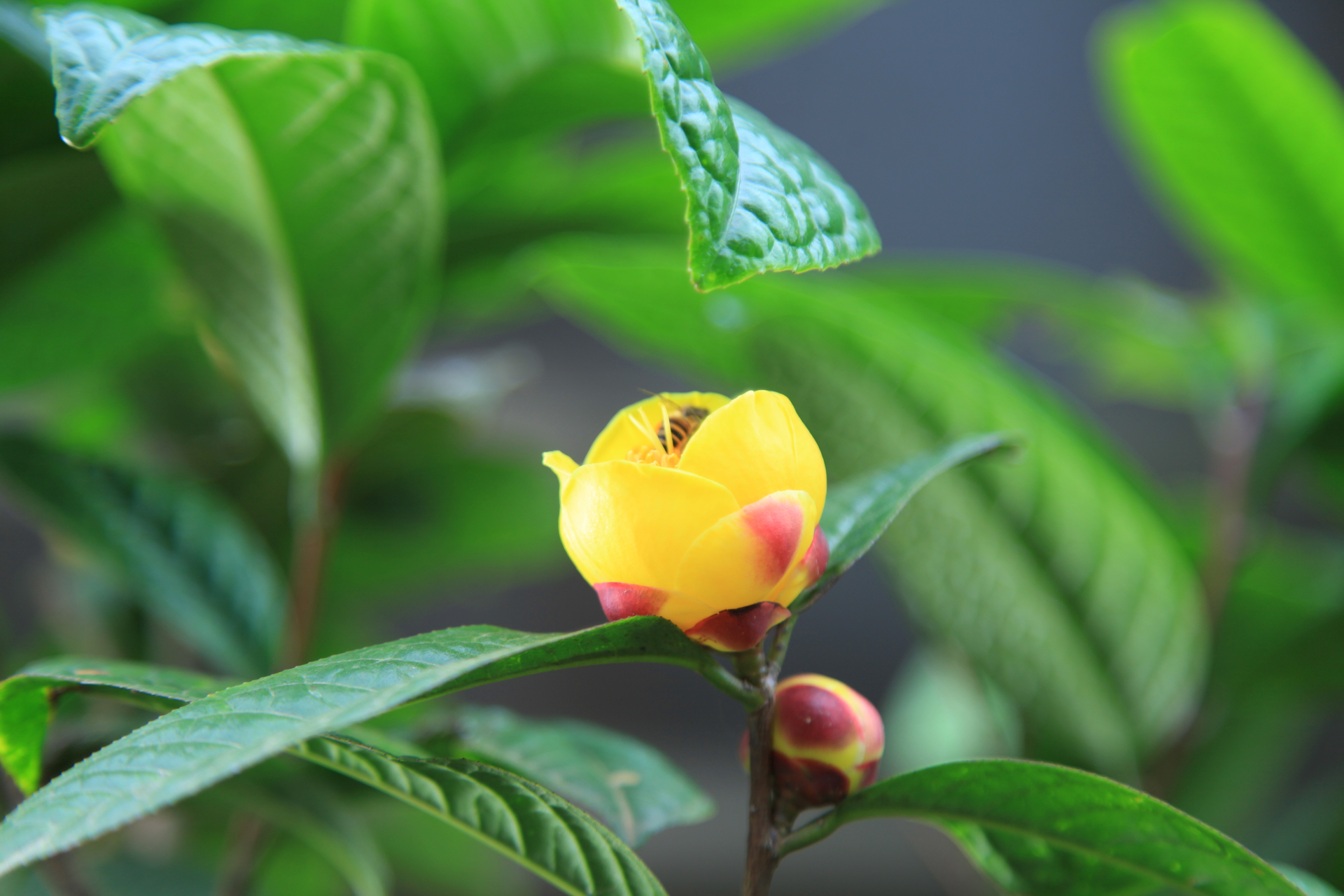

Currently, the whole district has over 200 hectares of golden camellia, mainly concentrated in the communes of Don Dac, Dap Thanh, Thanh Lam, Thanh Son, Nam Son, and Luong Mong. The average output of fresh golden camellia flowers reaches 20 tons/ year and fresh golden camellia leaves yield 65 tons/year. Revenue from golden camellia plants in the district reaches over VND 20 billion/year. Revenue from golden camellia plants in the district reaches over VND 20 billion/year.
Thanks to the economic value of the golden camellia plant, along with support from the new rural construction program (Program 135), after more than 10 years of development, golden camellia has contributed to improving the lives of highland people in Ba Che district. In 2015, the district's per capita income reached VND 17.5 million. By 2022, it had reached VND 55 million, an increase of over VND 37 million/person/year.
According to Mr. Tran Van Thuc, Director of the Quang Ninh Sub-Department of Crop Production and Plant Protection, the unit has currently developed a project to grow golden camellia in an organic direction and submitted it to the Provincial People's Committee with a total budget of VND 800 million to increase product value. Especially in 2022, Ba Che Golden Camellia has been granted a growing area code. This is considered a "passport" for golden camellia tea to enter the international market.
The Director of the Quang Ninh Sub-Department of Crop Production and Plant Protection added that households participating in growing golden camellia organically will be guided through the care process and provided with certified organic fertilizers. Besides, growers need to fully record production logs and strictly follow the guided process to ensure that product quality meets organic standards.
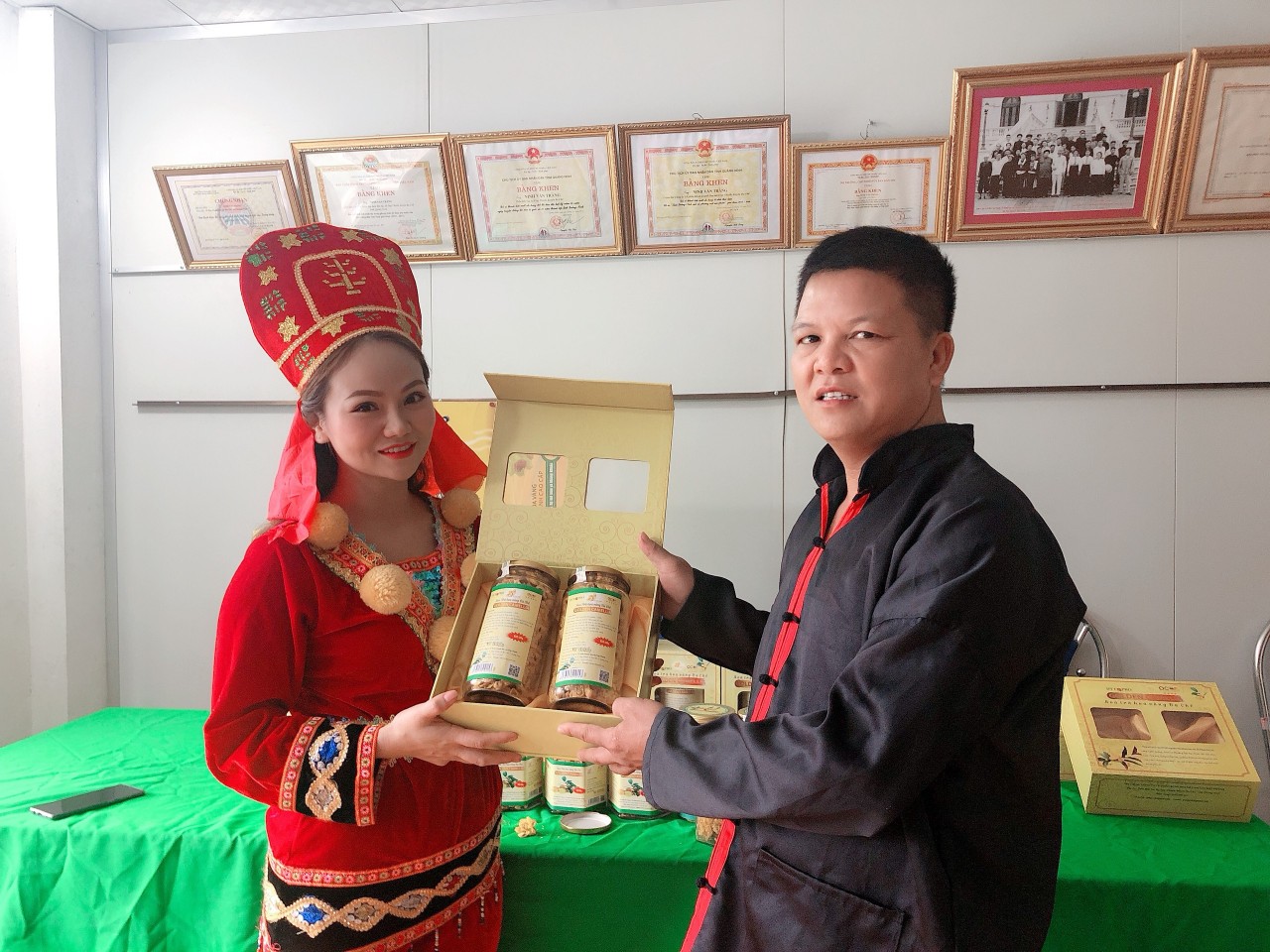

Over the years, golden camellia tea has become a branded OCOP product of Ba Che district in particular and Quang Ninh province in general and is highly appreciated by the market. Therefore, paying attention to creating raw material sources and growing areas for this product plays an important role in sustainable development.
According to assessments, from a herbal product with local advantages, golden camellia tea gradually becomes a quality OCOP product and is paid attention to investing in and upgrading to create prestige among consumers. In addition to being granted a certificate by the Intellectual Property Office of Viet Nam, in 2018, the Provincial People's Committee also approved a scientific project on researching the composition and effects of golden camellia tea.
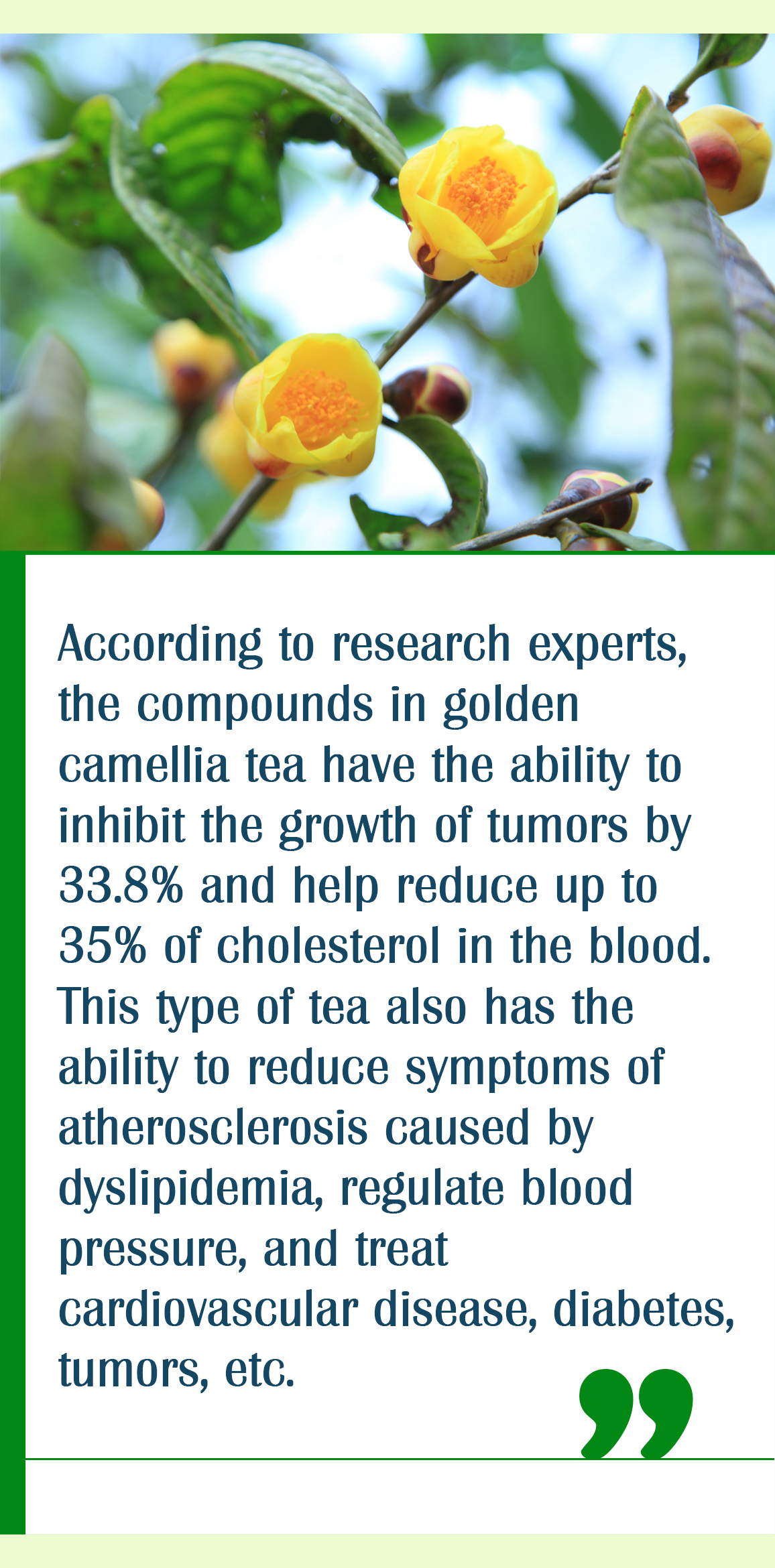
Currently, OCOP golden camellia tea products are continuously invested in to improve the quality and output of production and consumption. Accordingly, in addition to traditional golden camellia tea products, many new products, such as golden camellia tea matcha powder, tea bag products, etc., are also invested in research and creation.
Enterprises have also focused on increasing production capacity through technology investment and purchasing high-tech dryers and auxiliary equipment to achieve a total capacity of 10 tons of fresh flowers per 3-month harvest crop. According to statistics, the current average output of fresh golden camellia flowers reaches 20 tons/year, and fresh golden camellia leaves reach 65 tons/year. The annual revenue from golden camellia plants in the district is about VND 20 billion.
To further promote the golden camellia growing project, Ba Che district has consolidated records and expanded seed gardens; invested in increasing breeding capacity and seedling quality with a net house system and mist irrigation and drainage systems; and oriented and ensured raw material sources for key products through linkages with people.
In addition to developing growing areas and increasing planting areas, the district reviewed golden camellia-growing households in the district and surrounding areas and established a cooperation to sign a contract with Dap Thanh Forest Products Trading Joint Stock Company to receive support in terms of techniques, seeds, supplies, and assurance of raw material consumption.
At the same time, Ba Che district has called, attracted, and applied specially preferential policies and mechanisms for businesses, individuals, and households investing in the field of developing and processing medicinal materials. Thanks to that, the district has attracted businesses to build projects and detailed planning, expected to upgrade post-harvest golden camellia processing technology, thereby enhancing its brand and competitiveness in the market, aiming to export products internationally.
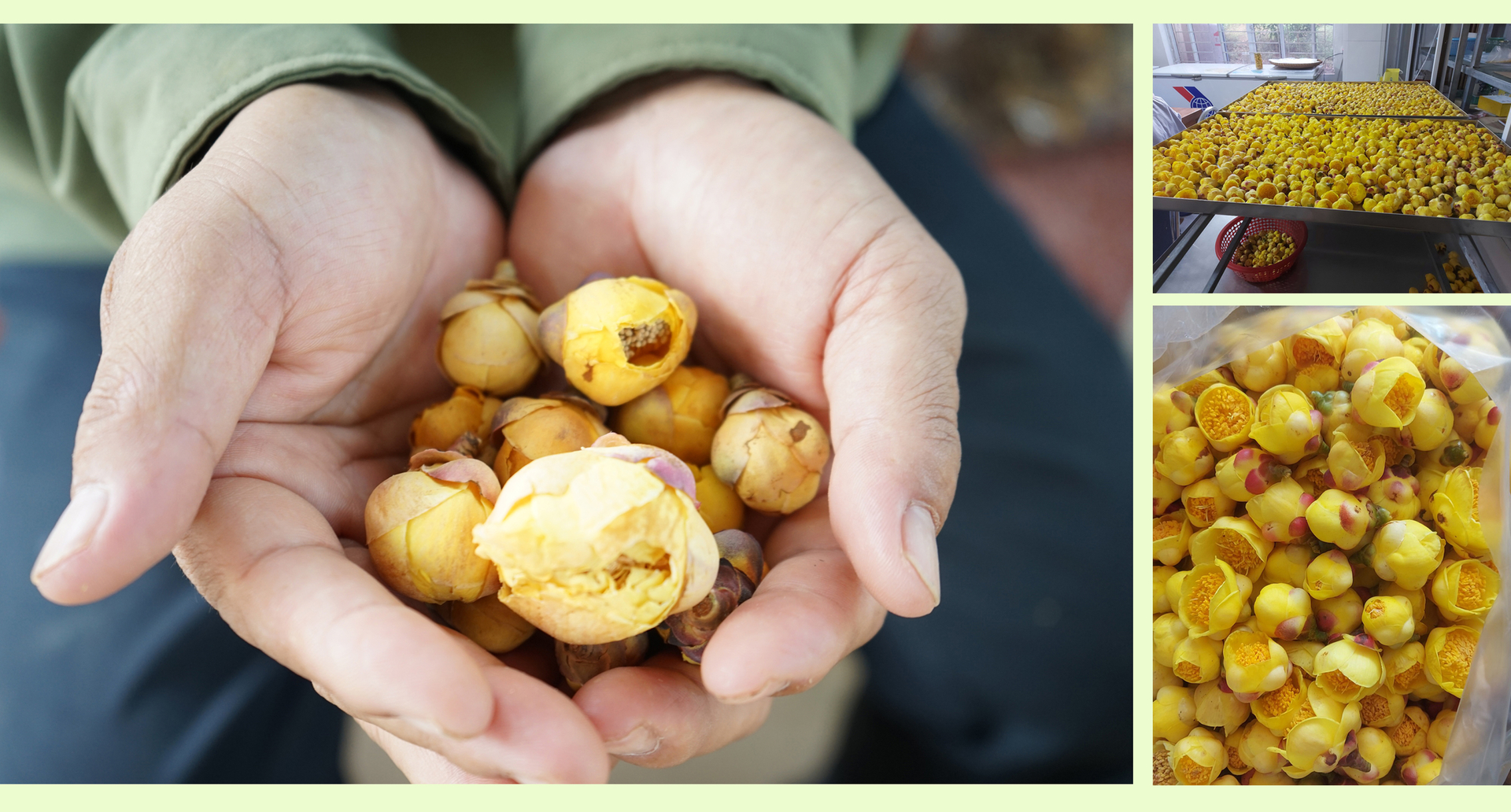
Content: Tien Thanh - Viet Cuong
Photo: Tien Thanh - Viet Cuong
Translated by: Huyen Vu Thu


